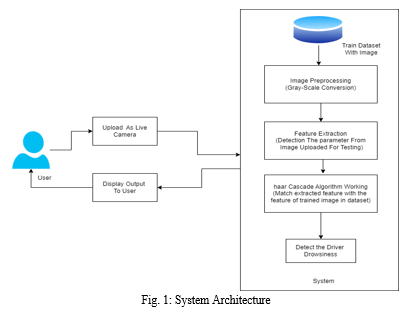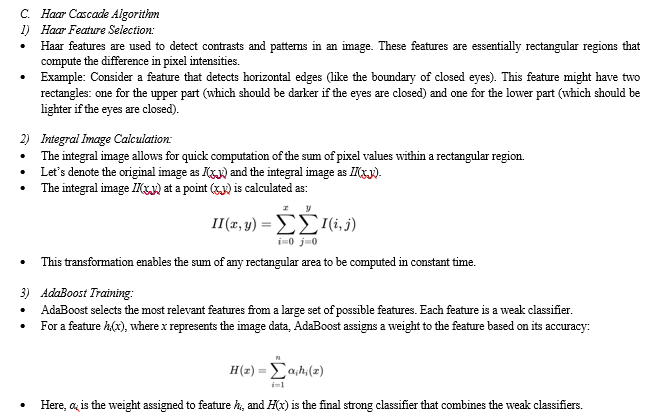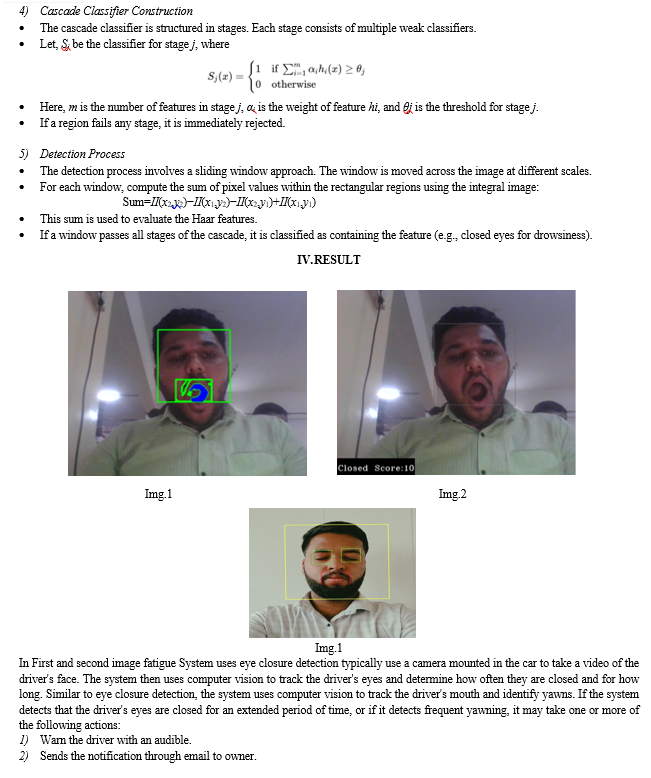Ijraset Journal For Research in Applied Science and Engineering Technology
- Home / Ijraset
- On This Page
- Abstract
- Introduction
- Conclusion
- References
- Copyright
Driver Drowsiness Detection using CNN
Authors: Jaitee Bankar, Siddhant Bhanage, Rudratej Patil, Shubham Shirke, Dnyanesh Shitole
DOI Link: https://doi.org/10.22214/ijraset.2024.62704
Certificate: View Certificate
Abstract
Driver drowsiness is a significant factor contributing to road accidents worldwide, posing a major threat to public safety. This project presents a robust and efficient approach to detecting driver drowsiness using Convolutional Neural Networks (CNN). The proposed system aims to enhance road safety by monitoring drivers in real-time and providing timely warnings to prevent accidents caused by fatigue. The methodology involves capturing video frames of the driver\'s face using a camera installed in the vehicle. The CNN model is trained on a comprehensive dataset containing images of alert and drowsy states. Key facial landmarks and features, such as eye closure duration, yawning frequency, and head position, are extracted and analyzed to determine the driver\'s level of alertness. By leveraging the powerful feature extraction capabilities of CNNs, the system can accurately distinguish between alert and drowsy states with high precision. Experimental results demonstrate the effectiveness of the proposed system in real-world scenarios, achieving a high accuracy rate in detecting drowsiness. The system\'s performance is evaluated against various benchmarks, showcasing its potential for integration into modern vehicles as a preventive safety measure. The deployment of this CNN-based drowsiness detection system can significantly reduce the risk of accidents, contributing to safer driving conditions and saving lives.
Introduction
I. INTRODUCTION
Driver drowsiness is a critical issue that significantly contributes to road accidents and fatalities worldwide. As the number of vehicles on the road continues to increase, ensuring the safety of drivers and passengers has become a paramount concern. Fatigue impairs a driver's reaction time, decision-making abilities, and overall attentiveness, leading to dangerous driving conditions. Consequently, developing an effective system to detect and prevent driver drowsiness is essential to enhancing road safety.
Traditional methods of detecting driver fatigue, such as self-reporting and manual observation, are often unreliable and impractical for real-time implementation. Recent advancements in machine learning and computer vision offer promising solutions to this problem. Convolutional Neural Networks (CNNs), a class of deep learning algorithms, have shown remarkable success in various image and video analysis tasks due to their ability to automatically extract and learn hierarchical features from raw data.
This project explores the use of CNNs for real-time driver drowsiness detection. By analyzing video frames captured from a camera installed in the vehicle, the system can monitor the driver's facial features and behaviours indicative of drowsiness, such as eye closure duration, yawning frequency, and head movements. The CNN model is trained on a diverse dataset of labelled images representing different states of alertness, enabling it to accurately distinguish between alert and drowsy drivers.
The implementation of a CNN-based drowsiness detection system in vehicles has the potential to significantly reduce the incidence of fatigue-related accidents. By providing timely warnings to drowsy drivers, the system can prevent dangerous situations and save lives. This project aims to contribute to the ongoing efforts in improving road safety through advanced technological solutions.
II. RELATED WORK
- Bappaditya Mandal-In this paper, this research focuses on the development of a robust system for detecting bus driver fatigue through visual analysis of eye states. Leveraging advanced computer vision techniques, the proposed approach aims to accurately identify signs of drowsiness by analysing the driver's eye movements and expressions. The system's effectiveness is evaluated using a comprehensive dataset, demonstrating promising results. The outcomes of this study hold significant potential for enhancing passenger safety and minimizing the risks associated with bus driver fatigue.
- Zuojin Li-In this paper, this research addresses the imperative need for transportation safety by developing an automatic system for detecting driver fatigue. By analysing driving operation information, such as steering patterns and pedal usage, the proposed approach employs machine learning techniques to identify signs of driver fatigue. The system's efficacy is evaluated through extensive experiments, showcasing its potential to enhance road safety by providing timely alerts and mitigating the risks associated with drowsy driving.
- Mr. Phil Hanley-In this paper, this study investigates the prevalent issues of fatigue and stress among bus drivers. Through a comprehensive analysis of factors contributing to driver fatigue and stress, the research aims to identify potential solutions and interventions. Insights derived from surveys, physiological measurements, and operational data provide a holistic understanding of the challenges faced by bus drivers. The outcomes of this study contribute valuable information to improve working conditions, enhance transportation safety, and mitigate risks associated with driver fatigue and stress.
- Thobias Sando-In this paper, this research investigates the potential causes of driver fatigue among transit bus operators in Florida. Through surveys, interviews, and data analysis, the study identifies key factors contributing to fatigue. Findings aim to enhance understanding and contribute insights for implementing targeted interventions to address driver fatigue issues, ultimately improving safety in transit operations.
- Dayang Nailul Munna-In thus paper, this study explores the multifaceted factors influencing bus driver fatigue and its correlation with the risk of accidents. Through surveys, incident data analysis, and driver interviews, the research aims to pinpoint key contributors to fatigue and their implications on road safety. The findings offer valuable insights for developing strategies to mitigate fatigue-related risks and enhance overall bus transportation safety.
- Herbert Biggsa-Author says, this research qualitatively explores the fatigue factors affecting metropolitan bus drivers. Through in-depth interviews and thematic analysis, the study identifies key contributors to driver fatigue in urban transit settings. The findings provide valuable insights for developing targeted interventions and strategies to improve the well-being and safety of metropolitan bus drivers.
- Bindu Bhatt-In this paper, this study investigates occupational health hazards faced by bus drivers. Through surveys, health assessments, and work environment analysis, the research identifies and examines the prevalent health risks associated with bus driving. The findings contribute valuable insights for developing targeted interventions and policies to improve the occupational health and well-being of bus drivers, ultimately enhancing workplace safety in the transportation sector.
III. FLOWCHART

A. User Interaction
- User: The user is the driver whose drowsiness is to be monitored.
- Upload as Live Camera: The system uses a live camera feed to capture video frames of the driver’s face in real-time. This step involves interfacing a camera with the system to continuously monitor the driver.
- Display Output to User: The processed output, indicating whether the driver is drowsy or alert, is displayed to the user. This could be in the form of an alert on a screen or an audible warning.
B. Core Processing Pipeline
- Train Dataset with Image: The first step involves training the system with a dataset of images. These images are pre-labelled to indicate different states of drowsiness (e.g., alert, slightly drowsy, very drowsy). This training data is crucial for the system to learn the distinguishing features of drowsiness.
- Image Pre-processing: The captured images from the live camera feed are pre-processed. This includes converting the images to gray-scale to reduce computational complexity and to enhance the key features needed for further processing. Gray-scale conversion helps in focusing on the intensity variations which are crucial for detecting features like eye closure and yawning.
- Feature Extraction: In this step, the system extracts relevant features from the pre-processed images. This involves identifying key facial landmarks and parameters such as eye closure, mouth opening (yawning), and head position. Feature extraction is essential for determining the driver’s state of alertness.
- Match Extracted Features with the Features of Trained Images in Dataset: The Haar Cascade algorithm is applied to detect specific features from the live camera feed. This algorithm uses the trained dataset to match the extracted features (like eye closure and yawning) with those of pre-labelled images. It efficiently identifies whether the current state matches that of a drowsy driver.
- Detect the Driver Drowsiness: Based on the feature matching and analysis, the system determines if the driver is drowsy. If drowsiness is detected, an alert is generated to notify the driver.
- System Output: The final component is the system itself, which integrates all these processes to provide a cohesive driver drowsiness detection mechanism. The system continuously monitors the driver in real-time and outputs alerts if drowsiness is detected.


V. ACKNOWLEDGMENT
We would like to express our sincere gratitude to all those who contributed to the successful completion of this research on Driver Drowsiness Detection using Convolutional Neural Networks (CNN). First and foremost, we extend our appreciation to our research team members for their dedication, collaboration, and valuable insights throughout the project. Their diverse expertise has been instrumental in shaping the methodology and findings. We are thankful for the support and resources provided by [Institution or Organization Name], which facilitated the execution of this research. Special thanks to [Supervisor/Advisor Name] for their guidance, encouragement, and constructive feedback that greatly enriched the quality of our work. Our heartfelt thanks go to the participants who willingly shared their time and experiences, contributing essential data for our study. Their involvement has been crucial in making this research more robust and applicable to real-world scenarios. Lastly, we acknowledge the broader scientific community for its continuous advancements, which have laid the foundation for the development and implementation of innovative technologies in the field of driver safety. This project represents a collaborative effort, and we are deeply appreciative of the collective contributions that have made it possible.
Conclusion
In conclusion, the application of Convolutional Neural Networks (CNNs) in driver drowsiness detection demonstrates significant promise for enhancing road safety. Through real-time analysis of facial features, CNNs can accurately identify signs of driver fatigue, offering a proactive mechanism to prevent potential accidents. However, ongoing research and development are essential to address challenges such as diverse datasets, real-world adaptability, and user acceptance, ensuring the continued improvement and effectiveness of CNN-based driver detection systems on the road.
References
[1] J. May and C. Baldwin, “Driver fatigue: The importance of identifying causal factors of fatigue when considering detection and countermeasure technologies,” Transp. Res. F, Traffic Psychol. Behav., vol. 12, no. 3, pp. 218–224, 2009. [2] S. Lal and A. Craig, “A critical review of the psychophysiology of driver fa- tigue,” Biol. Psychol., vol. 55, no. 3, pp. 173–194, 2001. [3] E. Hitchcock and G. Matthews, “Multidimensional assessment of fatigue: A review and recommendations,” in Proc. Int. Conf. Fatigue Manage.Transp. Oper., Seattle, WA, USA, Sep. 2005. [4] Williamson, A. Feyer, and R. Friswell, “The impact of work practices on fatigue in long distance truck drivers,” Accident Anal. Prevent., vol. 28, no. 6, pp. 709–719, 1996. [5] W. Dement and M. Carskadon, “Current perspectives on daytime sleepiness: The issues,” Sleep, vol. 5, no. S2, pp. S56–S66, 1982 [6] L. Hartley, T. Horberry, N. Mabbott, and G. Krueger, “Review of fatigue detec- tion and prediction technologies,” Nat. Road Transp. Commiss., Melbourne, Vic., Australia, Tech. Rep., 2000. [7] Sahayadhas, K. Sundaraj, and M. Murugappan, “Detecting driver drowsi- ness based on sensors: A review,” Sensors, vol. 12, pp. 16 937–16 953, 2012. [8] S. Kee, S. Tamrin, and Y. Goh, “Driving fatigue and performance among oc- cupational drivers in simulated prolonged driving,” Global J. HealthSci., vol. 2, no. 1, pp. 167–177, 2010. [9] M.-H. Sigari, M.-R.Pourshahabi, M. Soryani, and M. Fathy, “A review on driver face monitoring systems for fatigue and distraction detection,”Int. J. Adv. Sci. Technol., vol. 64, pp. 73–100, 2014.
Copyright
Copyright © 2024 Jaitee Bankar, Siddhant Bhanage, Rudratej Patil, Shubham Shirke, Dnyanesh Shitole. This is an open access article distributed under the Creative Commons Attribution License, which permits unrestricted use, distribution, and reproduction in any medium, provided the original work is properly cited.

Download Paper
Paper Id : IJRASET62704
Publish Date : 2024-05-25
ISSN : 2321-9653
Publisher Name : IJRASET
DOI Link : Click Here
 Submit Paper Online
Submit Paper Online

